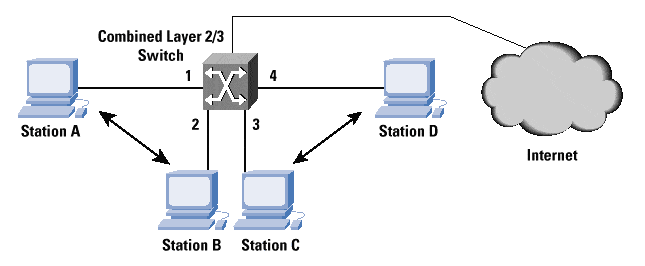Definition of Layer 3 switch in Network Encyclopedia.
What is Layer 3 switch?
Layer 3 switch is an Ethernet switch that switches packets by looking at both their network address (for example, their IP or IPX address) and their physical address (for example, their MAC address).
This type of switch operates at both the network layer (layer 3) and the data-link layer (layer 2) of the 7 layers OSI Model (Open Systems Interconnection reference model).
This kind of switch combines the speed of an Ethernet switch with some of the capabilities of a router for building advanced, high-speed Ethernet networks.

How it works
These switches perform on two levels: layer 2 and layer 3. Their layer 3 switching functionality can take one of two forms:
- Packet-by-Packet Layer 3 (PPL3) switches: These switches look into every packet to determine its logical layer 3 destination address (such as its destination IP address). PPL3 switches essentially function as high-speed routers with the routing functionality built into its hardware instead of software. Like routers, besides forwarding a packet to its destination, these switches perform other functions that a standard router performs, such as using the packet’s checksum to verify its integrity, updating the packet’s Time to Live (TTL) information after each hop, and processing any option information in the packet’s header. PPL3 switches typically communicate with each other using a routing protocol such as Routing Information Protocol (RIP) or Open Shortest Path First (OSPF) Protocol so that they become aware of the overall topology of the network.
- Cut-through switches: These switches look into only the first packet of a series of packets to determine its logical layer 3 destination address (such as the destination IP address), and then switch the remainder of packets in the series using the layer 2 address (MAC address). This leads to higher data throughput rates.
In addition to performing layer 3 switching functions (routing functions), these switches perform the functions of Layer 2 switches (bridging functions) at each switch interface. You can group switching interfaces in various ways to allocate bandwidth and contain broadcasts, which makes Layer 3 switches a powerful, scalable technology for building high-speed Ethernet backbone networks.
TIP
You can deploy a switch (layer 3) in your network anywhere a traditional router is used. The following table shows some of the differences between a traditional router and a switch with layer 3 capabilities.
Traditional Router vs. Layer 3 Switch
| Feature | Router | Switch (layer 3) |
| Local area network (LAN) protocols supported | IP, IPX, AppleTalk | IP, IPX, AppleTalk |
| Packet-forwarding method | Software-based | Hardware-based |
| Throughput | Lower | Higher |
| Definition of subnet | Per port | Per layer 2 switching domain |
| Support for policy-based routing | Less | More |
| Relationship with bridges | Peer | Layered |
| Cost | Higher | Lower |